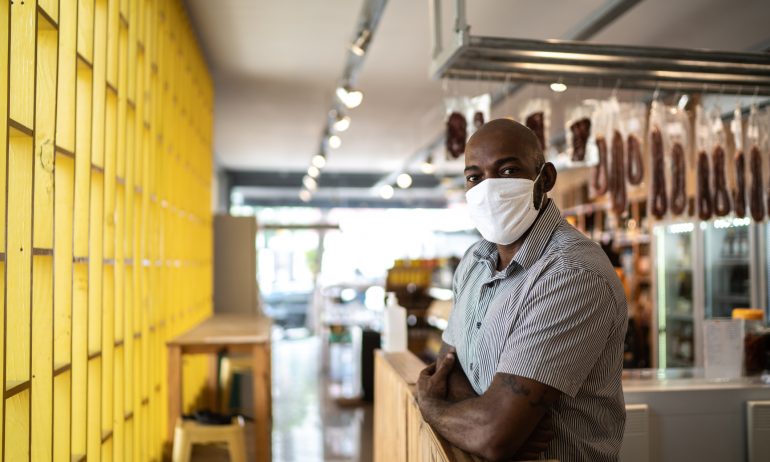13 Statistics That Show Which Businesses Are Getting PPP Loans

Many or all of the products featured here are from our partners who compensate us. This influences which products we write about and where and how the product appears on a page. However, this does not influence our evaluations. Our opinions are our own. Here is a list of our partners and here's how we make money.
Even just two months after the Paycheck Protection Program started guaranteeing low-interest, forgivable loans to small-business owners affected by the coronavirus pandemic across the U.S., one of the biggest questions people had about the program was “Where did the money go?”
The first round of PPP funding was marred by a bottleneck of applications, unclear guidelines and reports of big corporations from Shake Shack to the Los Angeles Lakers receiving loans. While the second round of funding went more smoothly, many are still wondering which businesses were able to reap the benefits of this taxpayer-funded program.
How much do you need?
We’ll start with a brief questionnaire to better understand the unique needs of your business.
Once we uncover your personalized matches, our team will consult you on the process moving forward.
PPP loan-approval stats: Which businesses received funding?
Using a combination of data collected by our partners at COVID Loan Tracker, as well as the data that the U.S. Small Business Administration has made available, we compiled a list of takeaways about which businesses received PPP loans as of June 2020.
Nearly 65% of all PPP loans were for loan amounts of $50,000 or less. According to the SBA, 64.9% of all respondents said that they received a loan for $50,000 or less.
Loans over $1 million made up less than 2% of all PPP loans. Large loan amounts got a lot of attention in the media; but according to SBA data, they made up less than 2% of all PPP loans disbursed. That being said, in terms of actual dollars, loans of over $1 million made up over 35% of all the loan dollars given out at that time. Loans under $50,000 made up just over 10% of loan dollars allocated.
The overall average PPP loan size: $113,000. According to SBA data, the average loan size was about $113,000 as of June of 2020.
The professional, scientific and technical services industry received the greatest number of PPP loans of any industry. This industry, according to NAICS, includes “legal advice and representation; accounting, bookkeeping and payroll services; architectural, engineering and specialized design services; computer services; consulting services; research services; advertising services; photographic services; translation and interpretation services; veterinary services,” and more. SBA data show that this industry received over 589,000 PPP loans, more than any other industry.
The health care and social assistance industry received the most net dollars from the PPP at the time. Although this industry, focused on medical workers and social workers, received over 100,000 fewer PPP loans than professional, scientific and technical services, it actually received more net dollars from the program with $66.1 billion, according to the SBA.
New Jersey and Colorado out-performed their populations. For the most part, the list of states that received the most loans (according to the SBA) and the list of states by population were aligned. California, the most populous state in the country, had the most PPP loans at 530,695. Texas, Florida and New York rounded out the top four, matching with their populations. There were a couple of small surprises among the top states, however. New Jersey received the eighth-most PPP loans in the country, despite being just 11th in population. Colorado received the 14th-most PPP loans but is just 21st in population.
Arizona lags behind a number of smaller states. According to the SBA, Arizona businesses received fewer PPP loans than a number of smaller states. While Arizona is 14th in the country in terms of population (and boasts one of the largest cities in the country in Phoenix), it trailed Massachusetts as well as Virginia, Colorado, Washington, Missouri, Tennessee and Wisconsin in terms of total PPP loans.
JPMorgan Chase disbursed the most PPP funding of any lender, while Bank of America made the most overall PPP loans. The SBA’s report lists the top 10 PPP lenders by total PPP funding, as well as each lender’s loan count and average loan size at the time. While JPMorgan Chase disbursed the most PPP funding with over $28 billion in loans, Bank of America made the most overall PPP loans with over 325,000. Of the lenders in the top five, Wells Fargo had the lowest average loan size ($59,408). PNC Bank had the fewest overall loans in the top five, yet had the highest average loan size ($179,848).
Smaller banks, CDFIs and non-bank lenders made over $97 billion in PPP loans. The SBA made a push to ensure people who bank with smaller lenders (such as banks with less than $1 billion in assets) or go through community development financial institutions, or CDFIs, and non-bank lenders have access to PPP. Of the more than $600 billion that was allocated to the PPP back then, over $97 billion was disbursed through a combination of small banks, small credit unions, fintechs, farm credit lenders, non-bank CDFI funds and other lenders with less than a billion in assets. Over 1.2 million PPP loans went through these lenders.
Nearly three-quarters of all PPP loans went to S Corporations and LLCs. According to COVID Loan Tracker’s survey, just under 75% of respondents that took out PPP loans said they were either an S Corp (38.8%) or an LLC (36.1%).LLCs and S Corps can be big businesses, but more often they are small — such as single-member LLCs. S Corps are also generally smaller than C Corps since they cannot have more than 100 stakeholders and are subject to pass-through taxation, similar to sole proprietorships.
Less than 10% of PPP loans went to sole proprietors and independent contractors. Only a small portion of respondents to COVID Loan Tracker’s survey said they were sole proprietors or independent contractors. In fact, respondents were more likely to be C-Corps (11.7% of all PPP loans went to these entities) than sole props (7.8%) or independent contractors (0.9%).
Most retail businesses — including restaurants and salons — received loans of $50,000 or less. According to COVID Loan Tracker, 55% of the loans that went to retail businesses were for $50,000 or less. Loan amounts are based on monthly average payroll, but the loans are also meant to cover expenses such as rent and utilities, which can be higher for retail businesses in major cities.
The vast majority of PPP loan applicants were approved — 97.2%. That means just 2.8% of PPP loan applicants were denied a loan when they applied, according to COVID Loan Tracker data. The PPP was designed to get money into the hands of business owners quickly, regardless of credit history or other factors that typically dictate loan approval success.
Note: Data from the SBA was current as of 6/6/2020.
This article originally appeared on Fundera, a subsidiary of NerdWallet.
On a similar note...


